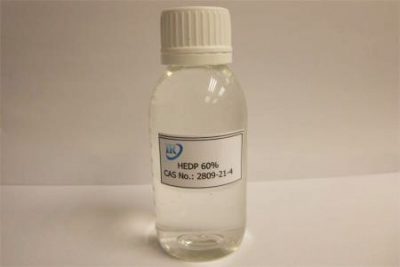Two Uses of Organic Phosphonic Acid, HEDP
HEDP is an organic phosphonic acid that can be used in many fields. HEDP and its sodium salts (HEDP Na, HEDP Na2, HEDP Na4) are called all-purpose organic phosphine products. HEDP and its sodium salts have occupied a large proportion of global sales of corrosion inhibitors.
Now, you will better understand HEDP and its sodium products here. Two Uses of Organic Phosphonic Acid, HEDP. They are scale Inhibitors and metal cleaning agents.

First, let us understand the inhibition mechanism of organic phosphonic acid.
As for the organic phosphonic acid, its inhibition mechanism is an electrodeposition film. The organic phosphonic acid in the water is a negatively charged ion. It reacts with calcium ions in water. They produce a positive and negative charge of complexing ions “Na2Ca2P6O6“.
Relying on the current generated during metal corrosion, this complex is deposited on the metal surface. This will hinder the contact of oxygen with metal. In this way, the effect of suppressing corrosion can be achieved.
Therefore, phosphine-based formulations require a certain concentration of calcium ions in water. Other organophosphorus scale inhibitors (such as HEDP, DTPMP) work in the same way.
The zinc salt forms a zinc hydroxide precipitate in the cathode, which suppresses the cathodic reaction and acts as a corrosion inhibitor. The formation of zinc film is fast, but the film is loose and weak. It is usually used with other corrosion inhibitors such as zinc phosphate. Because it deposits tightly on the metal surface as soon as it settles, it is relatively strong and compact.
Usually, several inhibitors, like HEDP, DTPMP. They are used together in a certain proportion. Several kinds of corrosion inhibitors are used together with certain proportions, which is smaller than the amount used alone, and the effect is better. This is the so-called “synergy effect”.
HEDP Used as Scale Inhibitor
Scale inhibitors remove and prevent scaling, improve heat transfer efficiency, and reduce energy and fuel consumption. In the water treatment industry, HEDP can also reduce sewage discharge and increase water utilization.
HEDP is used as a scale inhibitor to disperse insoluble inorganic salts in water. HEDP scale inhibitors prevent or interfere with precipitation and scaling of insoluble inorganic salts on metal surfaces. At the same time, HEDP scale inhibitors can maintain good heat transfer performance of metal equipment.
HEDP Used as Metal Cleaning Agent
The cleaning temperature of HEDP used as a metal cleaning agent is generally 50 ~ 85 °C. Dilution oil cleaning temperature is 50~60°C. Heavy oils have a higher temperature of higher melting point oils. The cleaning time of the HEDP cleaning agent is related to the cleaning method.
According to the characteristics of the cleaning agent, the cleaning time is 2 to 10 minutes or more.
Cleaning methods include immersion cleaning, spray cleaning, ultrasonic and multi-stage cleaning. The cleaning process is generally: washing, rinsing, dehydration, and rust-proof treatment.
For example, the pre-plating cleaning process for oil contaminated parts is as follows. Degreasing, washing, pickling, washing, alkaline soaking (ultrasonic), anodic electrolytic cleaning, washing, activating, washing and plating.
HEDP acid is a typical metal cleaning agent. HEDP acid has its own acidity and excellent chelating activity. HEDP can chelate, dissolve and disperse special dirt such as oxide layer adhering to the metal surface to achieve the purpose of cleaning.
IROCHEM has a long-term supply of high-quality HEDP and its sodium products.
Title:
Two Uses of Organic Phosphonic Acid, HEDP
Source: https://www.irohedp.com/two-uses-organic-phosphonic-acid-hedp/